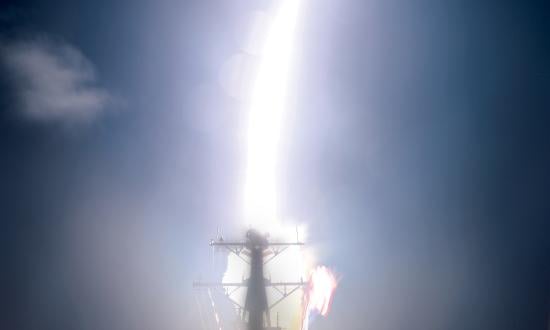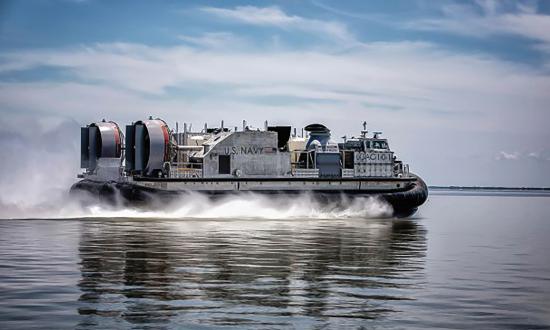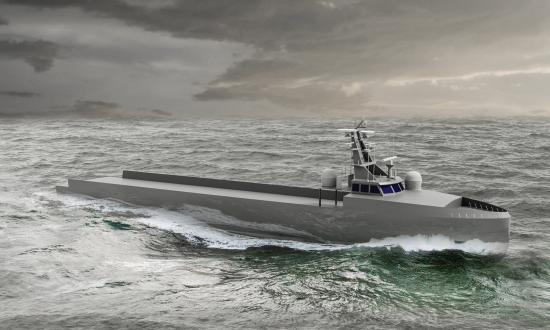Later this year, the Navy plans to install a production high-energy solid-state laser system on board a West Coast Arleigh Burke–class guided-missile destroyer (DDG). The system, now called the High-Energy Laser with Integrated Optical Dazzler and Surveillance (HELIOS) unit, was developed as increment 1 of the Surface Navy Laser Weapon System program.
Vice Admiral Ron Boxall says the funding is already in place for HELIOS installation on board a Flight IIA ship.
Lockheed Martin’s Integrated Warfare Sensor Systems developed the HELIOS under a $150 million contract awarded in January 2018 for one system for ship installation and a second for land-based testing. The award includes options for 14 more.
Joe Ottaviano, the company’s business development director, says the system went through critical design review and factory qualification testing last year. It was delivered to a Navy test site in December. He says it already has been integrated with the Aegis combat system in various configurations for the different destroyer flights.
For years, the Navy has researched lasers and other directed-energy weapons (such as microwave and particle-beam systems) to advance ship defense against surface craft, aircraft, antiship missiles, and unmanned vehicles. A laser, drawing power from the ship service power system, has an “endless magazine” that Ottaviano says “never runs out of bullets.”
The Navy wants a 60-kilowatt (kW) shipboard solid-state laser that could be increased up to 150 kW. Subsequent increments will ramp up power even further. The Navy’s Fiscal Year 2021 budget request says the system “provides a low cost-per-shot capability” for antisurface warfare; to destroy unmanned aerial systems and fast inshore attack craft; and for intelligence, surveillance, and reconnaissance, thanks to its integrated optics.
The development is part of the Navy’s Laser Family of Systems program, which includes two other initiatives: the solid-state laser technology maturation (SSL-TM) program, an Office of Naval Research (ONR) effort, and an optical dazzling interdictor known as ODIN.
The Department of Defense has been working on lasers since the 1970s, starting with research into chemical lasers for use against land and airborne targets. The Missile Defense Agency began an acquisition program with Boeing and others in 2001 for the high-energy chemical YA-1 Airborne Laser integrated into a modified 747 aircraft.
Solid-state laser technology was introduced in the early 2000s, and ONR started its solid-state program around 2015. ONR program manager Peter Morison noted then that the High-Energy Laser Joint Technology Program initiated a Robust Electric Laser Initiative, which led to collaborative research with industry on multiple laser types. ONR has supported several, including a 30-kW laser weapon system (LaWS) demonstrator and the Mk 38 tactical laser system. Raytheon, Northrop Grumman, and BAE Systems have developed concepts for 100 to 150 kW prototypes.
In 2014, the Navy installed a solid-state LaWS prototype on board the now-decommissioned afloat forward staging base testbed USS Ponce (AFSB-15) for at-sea testing to gather data for future work.
Ottaviano says the HELIOS work leveraged mature technologies, such as the beam controller and beam director, which control how the system combines the laser beam during firing. He says also that the HELIOS capability has been incorporated into the Aegis common source library, a Navy repository of the combat system software programs for the Aegis ships, including the Australian, South Korean, Japanese, Norwegian, and Spanish ships that use Aegis.
In March 2020, Lockheed Martin won a $22.4 million contract for integration, demonstration, testing, and operation of a layered laser defense weapon prototype on board a littoral combat ship. That work is set for completion in July.
Boxall says that the new Flight III DDGs are not HELIOS candidates because the newer destroyers must dedicate considerable power to the new SPY-6(v) radar. Something else would have to be removed from the Flight IIIs to get HELIOS on board, he says.






